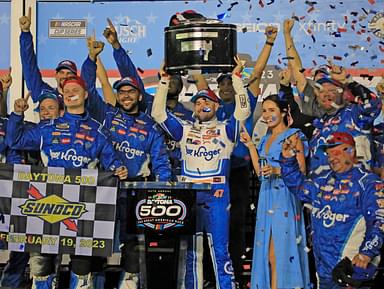There have been plenty of memorable Daytona 500s in history. The 1963 running takes one of the top spots among them for the heroics of one particular driver by the name of Tiny Lund. At a height of 6 feet 5 and a weight of 260 pounds, DeWayne Louis “Tiny” Lund was a giant among men. But his soft-spoken character and kind nature were nowhere reflective of his appearance.
Advertisement
This man who was but an occasional driver in the top tier got the opportunity of a lifetime a few days before the Great American Race in 1963. Bill France had announced a prize of $10,000 to any driver who could exceed a speed of 180 miles per hour in their car before the main race. Wood Brothers Racing driver Marvin Panch decided to test his luck.
He was further inspired when the company that used a Maserati at the Le Mans wanted to test the car with a stock car racing engine. It was looking for a test driver and Panch signed up.
However, things went astray on the track. The Maserati flipped as it entered Turn 3 and burst into flames. The driver tried his best to get out but to no avail. This was when Lund and a few others arrived on the scene.
They lifted the car with great difficulty and the big man pulled Panch out with all his force saving life. Lund had been in Daytona trying to land himself a car for the upcoming big race.
All of a sudden, he was being asked if he would want to fill in for Panch in it. The injured driver too wanted the same along with his team owners and the deal was signed. The story began just then.
Lund surprises the racing world with Daytona 500 victory
The driver was determined to not let this opportunity that fell on his lap go to waste. He started the race in 12th place. The Wood Brothers Racing crew knew that they wouldn’t be able to win depending on raw speed. So, they drew up an unusual strategy to give Lund a better chance.
They were going to use a single set of tires for the entire race and come to the pits for one fewer fuel stop. Leonard Wood explained years later,
“Nobody had ever run 500 miles on one set of tires. I thought we could because I built my own spindles, ones that reduced tire roll. It was something of mine that nobody else had. It made the tires wear even all the way across the footprint.”
The strategy ended up working. Lund’s pit stops were a lot quicker since he didn’t change tires and he was able to gain a lot of time because of this. He eventually led 17 laps of the 200 and beat Ned Jarrett along with Fred Lorezen to reach the checkered flag first.
There are but a few such stories of heroism in the pages of history. Lund saved Panch’s life and went on to take his car to victory lane in the biggest race of the season. He was later awarded with a Medal of Heroism by the Carnegie Foundation.



